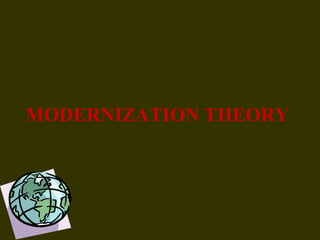A Presentation on Modernization theory
- 2. "MODERNITY"? A crude view would hold that "modernity" is the endpoint of a process called "modernization."
- 3. ŌĆó "modernity" is measured by "urbanization," "industrialization," "literacy," and so on ŌĆó "image of the modern" has been one of "literate people living in cities making a living by manufacturing
- 4. ŌĆó First, why are these specific "markers" of "modernity" (e.g., urbanization, literacy, industrial output) particularly privileged? ŌĆó Second, what, exactly, is being measured? Such a crude perspective provokes (at least) four objections.
- 5. ŌĆó if "industry" is the critical category, what percentage of output must be "industrial" for a society to be counted as "modern"? ŌĆó What constitutes "industrial" production these days? Are transgenetic crops "agricultural" or "industrial"? Does a large "industrial" sector always matter? What about "services"? ŌĆó Does "urban" mean "an agglomeration of settlements with more than 100,000 people"? Why that number?
- 6. ŌĆó Finally, history is conceived as a process toward a predetermined goal. All societies, in this view, move toward an "end-point" of "modernity," which very closely resembles the current society of the United States or Western Europe. ŌĆó All humanity marches toward the same shining goal, the End of History. ŌĆó Since the inception of modernization theory, many have wondered who the agents of this process were, what they themselves wanted, how they saw their situation, and whether it could really be true that differences would, inevitably, be replaced by sameness.
- 7. ŌĆó Modernization theory is the historical product of three main events in the post-World War Two era:┬Ā 1) the rise of the United States as a superpower to contain the growth of the international communist movement. For this,the United States financed the industrialization of Western Europe ( Marshall plan), the industrialization of South Korea and Taiwan, and the reconstruction of Japan.
- 8. 2) the growth of a united worldwide communist movement led from Moscow and later on also from Beijing (with Soviet Union, People's Republic of China, Vietnam and Cuba as hot points).┬Ā 3) the process of de-colonisation in Africa and Asia as an outcome of the disintegration of the former European colonial empires. ŌĆ”the new nation-states were in a search for a model of development
- 9. ŌĆó Thus, the United Sates political and economic elites encouraged their social scientist to study the new nation-states, to devise ways of promoting capitalist economic development and political stability, defined as "social order", SO AS TO AVOID LOSING THE OLD AND NEW STATES TO THE SOVIET COMMUNIST BLOC.
- 10. United States political scientists, economists, sociologists,psychologists, anthropologists, and demographers teamed up and started publishing since the early 1950s.┬ĀThey adopted a) EVOLUTIONARY THEORY b) FUNCTIONALIST THEORY
- 11. EVOLUTIONARY THEORY The classical evolutionary theory stated the following:┬Ā 1) social change is unidirectional, from a primitive to an advanced state, thus the fate of human evolution is predetermined.┬Ā
- 12. EVOLUTIONARY THEORY 2) it imposed a value judgement on the evolutionary process: the movement toward the final phase is GOOD because it represents PROGRESS, HUMANITY, and CIVILIZATION, the latter three concepts defined in accordance with Western European cultural parameters.┬Ā
- 13. 3) it assumed that the rate of SOCIAL CHANGE is slow, gradual, and piecemeal. Most importantly, social change, in accordance with Charles Darwin approach to biological development, was VOLUTIONARY, not EVOLUTIONARY. 4) the process (from primitive to complex modern societies) will take centuries to complete.
- 14. FUNCTIONALIST THEORY Functionalist theory, as presented by Talcott Parsons, 1951, had the following tenets:┬Ā 1) human society is like a biological organism, with different parts corresponding to the different institutions that make up a society
- 15. a) adaptation to the environment ŌĆō performed by the economy, but not any economic system, only capitalism can adapt to the environment┬Ā b) goal attainment ŌĆō performed by the government, pursuing liberal aims as defined by English and French thinkers. 2) each institution performs a specific function for the good of the whole, thus there are FOUR CRUCIAL FUNCTIONS that every institution must perform to maintain the social fabric:
- 16. c) integration ( linking the institutions together) ŌĆō performed by the legal institutions and religion. But not any religion. Branches of the judeo-christian religions were the right ones.┬Ā d) latency ( pattern maintenance of values from generation to generation ) ŌĆō performed by the family as an a historical basic human organization, and education.
- 17. ŌĆó Functionalist theory stated that societies tend to harmony, stability, equilibrium and the status quo. ŌĆó Any behaviour jeopardizing these conditions will be considered anti-social and therefore punishable, etc. ŌĆó Modernization theory characterised societies as follows:
- 18. TRADITIONAL SOCIETIES social relationships tend to have an affective component-personal, emotional, and face-to-face, which is a constraint in the process of developing efficient relations of production via a market.┬Ā MODERN SOCIETIES social relationships are NEUTRAL -impersonal, detached and indirect, which make possible efficient market relationships, etc.
- 19. ŌĆó Much of its origins depends on analogies with biological systems, and in just the way that a biologist might study the role of some physiological aspect,some set of cells, in the maintenance of life, functionalists have tried to understand what are the necessary "functions" that must be carried out in any political system if it is to cope with its environment and achieve its goals, and to locate the "structures"(political parties, socializing agencies like churches, family,etc) which facilitate
- 20. ŌĆó One very important structure for modernization theory, the family institution, have been conceptualized as follows: ŌĆó THE TRADITIONAL FAMILY is multifunctional was responsible for: 1. reproduction 2. emotional support 3. production (the family farm) 4. education ( informal parental socialization) 5. welfare ( care of the elderly )
- 21. ŌĆó THE MODERN FAMILY is small and nuclear, the state take over the education, welfare and religion functions and the individual takes over production. Reproduction becomes ambiguous, etc





















